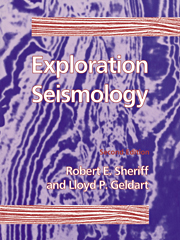Book contents
- Frontmatter
- Contents
- Preface
- Mathematical conventions and symbols
- 1 Introduction
- 2 Theory of seismic waves
- 3 Partitioning at an interface
- 4 Geometry of seismic waves
- 5 Seismic velocity
- 6 Characteristics of seismic events
- 7 Equipment
- 8 Reflection field methods
- 9 Data Processing
- 10 Geologic interpretation of reflection data
- 11 Refraction methods
- 12 3-D Methods
- 13 Specialized techniques
- 14 Specialized applications
- 15 Background mathematics
- Appendices
- Index
11 - Refraction methods
Published online by Cambridge University Press: 05 June 2012
- Frontmatter
- Contents
- Preface
- Mathematical conventions and symbols
- 1 Introduction
- 2 Theory of seismic waves
- 3 Partitioning at an interface
- 4 Geometry of seismic waves
- 5 Seismic velocity
- 6 Characteristics of seismic events
- 7 Equipment
- 8 Reflection field methods
- 9 Data Processing
- 10 Geologic interpretation of reflection data
- 11 Refraction methods
- 12 3-D Methods
- 13 Specialized techniques
- 14 Specialized applications
- 15 Background mathematics
- Appendices
- Index
Summary
Overview
Refraction work generally can be divided between that designed to define deep structural features and that aimed at defining the near surface, the latter including most engineering studies and determining statics corrections for reflection data processing. The data to define deep structural features have often been insufficient (simply to keep costs down) and the interpretation oversimplified (for example, assuming constant overburden velocity and nearly planar refractors); consequently, precise results were not expected. Traditional interpretation was a hand-craft art employing many ingeneous methods (we describe a few), but little work of this type is done today. On the other hand, considerable near-surface refraction is being done. The need for simplification is much less and methods such as the GRM (§11.3.3) have been developed to accomplish more precise results. Differences between achieving different refraction objectives affect mainly the scale of acquisition operations.
Refraction and reflection work are similar in many aspects, much different in others. The similarities are sufficient that reflection field crews sometimes do refraction profiling, though often not with the efficiency of a crew specifically designed for refraction. The differences between reflection and refraction field work for defining deep features mostly result from the long source-to-geophone distances employed in refraction. The energy input to the ground must be larger for refraction work and explosives continue to be the dominant energy source where longer distances are involved although other seismic sources are also used.
- Type
- Chapter
- Information
- Exploration Seismology , pp. 425 - 450Publisher: Cambridge University PressPrint publication year: 1995



